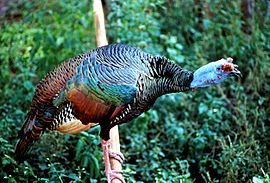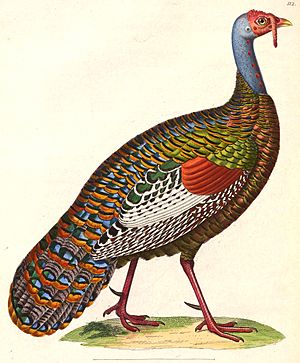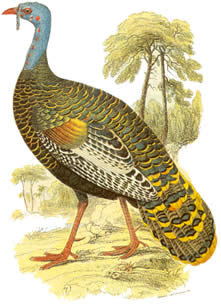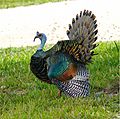Ocellated Turkey facts for kids
Quick facts for kids Ocellated Turkey |
|
|---|---|
 |
|
| Scientific classification | |
| Kingdom: | |
| Phylum: | |
| Class: | |
| Order: | |
| Family: | |
| Genus: | |
| Species: |
M. ocellata
|
| Binomial name | |
| Meleagris ocellata |
|
The Ocellated Turkey (Meleagris ocellata) is a large bird that looks a lot like the turkeys you might know from North America. Its name comes from the special eye-like spots on its tail feathers. Ocellated means "having eye-like spots," which perfectly describes this unique bird!
What Does the Ocellated Turkey Look Like?
Both male and female Ocellated Turkeys have beautiful feathers. Their body feathers shine with a mix of bronze and green colors. This shimmering effect is called iridescence. Even though females might look a bit duller with more green, you can't tell if a turkey is male or female just by looking at its chest feathers. Unlike many other wild turkeys, neither the male nor the female Ocellated Turkey has a "beard" (a tuft of coarse feathers on the chest).
The tail feathers are bluish-grey. Each feather has a special eye-shaped spot that is blue and bronze, with a bright gold tip. These spots are called ocelli, and they are why the turkey is named "ocellated." They look a lot like the patterns you might see on a peafowl's tail. The feathers on their upper wings are a shiny copper color. Their main wing feathers look similar to those of North American turkeys. However, the Ocellated Turkey's secondary wing feathers have more white, especially around the edges.
Both male and female Ocellated Turkeys have blue heads. They also have some orange or red bumps, called nodules, on their heads. These bumps are much more noticeable on males. Male turkeys also have a fleshy blue crown on top of their heads, covered with nodules. This crown is similar to the ones on their necks. During the breeding season, this crown swells up and becomes brighter, turning a strong yellow-orange color.
A bright red ring of skin surrounds the eye of both sexes. This red ring is easiest to see on males during the breeding season. Their legs are a deep red color. They are also shorter and thinner than the legs of North American turkeys. Male turkeys that are older than one year have spurs on their legs. These spurs are sharp growths that average about 4 centimeters (1.6 inches) long. Some can even be longer than 6 centimeters (2.4 inches)! These spurs are much longer and thinner than those found on North American turkeys.
Ocellated Turkeys are smaller than any of the different types of North American wild turkeys. Adult female turkeys weigh about 4 kilograms (9 pounds) before they lay eggs. The rest of the year, they weigh around 3 kilograms (6-7 pounds). Adult male turkeys weigh about 5 to 6 kilograms (11-13 pounds) during the breeding season.
Behavior and Life Cycle
Ocellated Turkeys spend most of their time on the ground. If they sense danger during the day, they usually prefer to run away rather than fly. However, they can fly very fast and powerfully for short distances if they need to. At night, they usually roost (rest) high up in trees. This helps them stay safe from predators that hunt at night, like jaguars. They often roost together in family groups.
These turkeys eat many different kinds of food. They enjoy insects like beetles, moths, and leafcutter ants. They also eat grass seeds, nuts, and leaves.
The breeding season for the Ocellated Turkey starts in early February. This is when the first gobbling sounds are heard from the males.
Male Ocellated Turkeys use their tail feathers to show off, just like North American turkeys. However, their mating dance has some unique differences. First, the male turkeys tap their feet on the ground very quickly. Then, they move their tail feathers from side to side. At the same time, they quickly vibrate their wings and drag the tips of their wings on the ground. As the male performs this dance, he moves around the female. He makes sure she can always see the top side of his tail feathers.
Ocellated Turkey chicks, called poults, hatch between May and July. The eggs take about 28 days to hatch. Female Ocellated Turkeys lay 8 to 15 eggs in a nest hidden on the ground. The poults are born covered in reddish-brown feathers. This helps them blend in with their surroundings and hide from predators. The young poults are precocial, which means they can leave the nest after just one night. They follow their mother until they are almost grown up. Then, they start to explore on their own, but they often meet up again to roost.
The sounds that female Ocellated Turkeys make are similar to those of their relatives in the north. However, the male's special call, known as a "gobble," sounds quite different.
Images for kids
See also
 In Spanish: Pavo ocelado para niños
In Spanish: Pavo ocelado para niños





